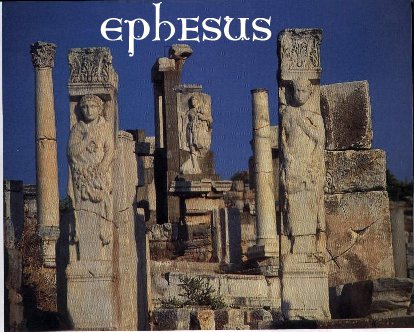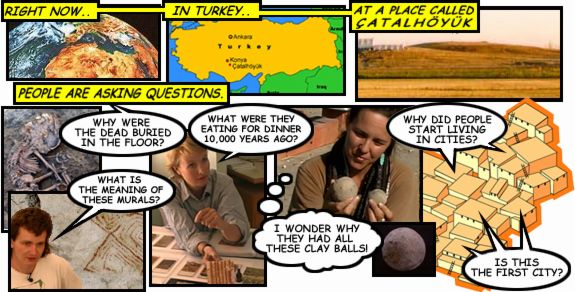What was the secret, the special genius, of Catal Huyuk, and did it have any connection with the Amazons? Was it the beginning of the thread that would wind itself through the millennia and end up weaving the haunting image of the women warrior?
L.W.Wilde
There
were no disputes between unfriendly
nations
as the harbour was believed to be under the protection of the goddess,
Ephesia, and had been internationally recognized as a sacred area since
3000 BC. According to local legends the Amazons took refuge here in flight
from Herakles.
In
7th century BC the temple of Artemis, goddess of hunting, was invaded by
wild Cimmerian warriors, but they did little more than threaten the locals,
perhaps because they feared Ephesia.

The
magnificent temple of which Christian writers speak as that
of
"the great Goddess whom all Asia and the world worshippeth" replaced the
earlier and more famous shrine which burned to the ground on the night
of Alexander's birth. Two hundred and twenty years had been spent
in the process of building the first temple, and when this was destroyed
the Ephesians at once began the construction of another even more costly.
The older Artemisium is said to have possessed among its treasures
four statues of Amazons executed by four of the most distinguished sculptors
of the fifth century, Phidias, Polyclitus, Cresilas, and Phradom.
The tradition is only on of many which indicate very close connection between
the Amazons and this sanctuary.
The
Ephesians themselves looked upon their Artemisium as one of the most sacred
spots in the whole world.
The Amazons are noticed in legend as founders of the shrine.Justin (2.4) states the tradition that the city itself was founded by the Amazons. We must, indeed, believe that the Amazons stood in intimate relation to the cult of Ephesian Artemis.
Mary Florence Bennett

Mysteries of Çatalhöyük ©1998, 1999 Science Museum
of Minnesota
Go to the links page to visit this website.
February 25, 1997
Ancient Graves of Warrior Women Offer
Hints of Amazons
By JOHN NOBLE WILFORD
he ancient Greeks could certainly tell a good yarn. Cultivating a
kernel of fact, or less, they could bring forth a feast of a story to
nourish imaginations down through the ages. One such tale was about a
society of fierce warrior women -- the Amazons.
In the account by the historian Herodotus in the fifth century B.C.,
Greek soldiers on a campaign in the Black Sea region found themselves
in combat against an army of women. Although the Greeks won, their
foe made a lasting impression. Here were women who did not confine
themselves, as Greek women did, to cooking and weaving and other
domestic roles. They lived to fight and were required to kill an enemy
before marrying. They even cut off their right breasts, the better to shoot
with bows and arrows.
Or so the story went. Herodotus conceded that, in all honesty, he had
never seen an Amazon; his tale was based on hearsay. But
archeologists excavating graves in the Eurasian steppes are now finding
evidence that there may be something to the Amazon legend after all.
Over the last four years, American and Russian archeologists have
examined 44 mounds, or kurgans, near the town of Pokrovka in
Kazakhstan at the Russian border, where ancient nomad cultures buried
their dead. From the grave goods and other evidence, the burials
appeared to be associated first with the Sauromatians and then the early
Sarmatians, Indo-European-speaking herders who lived on the steppes
in the sixth to fourth centuries B.C. and fourth to second centuries B.C.,
respectively.
But the most striking discovery at Pokrovka has been the skeletons of
women buried with swords and daggers. One young woman,
bow-legged from riding horseback, wore around her neck an amulet in
the form of a leather pouch containing a bronze arrowhead. At her right
side was an iron dagger; at her left, a quiver holding more than 40
arrows tipped with bronze.
"These women were warriors of some sort," said Dr. Jeannine
Davis-Kimball, a leader of the excavations. "They were not necessarily
fighting battles all the time, like a Genghis Khan, but protecting their
herds and grazing territory when they had to. If they had been fighting
all
the time, more of the skeletons would show signs of violent deaths."
In that case, the Sauromation-Sarmation women probably did not quite
fit the larger-than-life Amazon image of women who seemed to prefer
making war to making love. Also, the women at Pokrovka lived more
than 1,000 miles east of the Amazons the Greeks supposedly
encountered. So Dr. Davis-Kimball is not jumping to any conclusions
that these women were indeed the Amazons of legend, only suggesting
that they could be contemporaries of the Amazons or that their lives,
and those of similar nomadic women who could ride and wield a sword
or dagger in combat, may have inspired the legend.
In the earlier Sauromatian graves, the skeletons revealed one suggestive
Amazonian attribute. The men and women, at an average of 5 feet 10
inches and 5 feet 6 inches, respectively, were taller and more robust
than normal people at that time.
Of more importance, the new discoveries are forcing anthropologists
and historians to reconsider the status and role of women in the
Eurasian nomad societies of the first millennium B.C. The research, she
said, showed that women seemed to have more wealth, power and
status in these cultures than anyone had thought. And certain women,
perhaps the elite of the tribe, appeared to be trained from an early age
to be warriors on horseback.
Dr. Davis-Kimball, an archeologist at the Center for the Study of
Eurasian Nomads in Berkeley, Calif., described the Pokrovka research
in an article in the current issue of Archaeology magazine and in a more
scholarly report to be published soon in The Journal of Indo-European
Studies. She and other specialists in Central Asian archeology discussed
the interpretations in interviews last week.
In her analysis, Dr. Davis-Kimball said burials at Pokrovka and other
sites seemed to reveal three categories for women of the culture.
Graves with luxury goods, including beads, colored glass and gilted
earrings, suggested that the "most frequently found status among
females," she said, "is that of femininity and the hearth." The women in
a
few graves might have been priestesses; they were buried with stone
altars, bronze mirrors used in healing and other cultic materials. Finally,
there were the warrior women.
Dr. Nicola DiCosmo, a historian of Central Asia at Harvard University,
said that other archeological findings in the steppes from Russia to
Mongolia seemed to indicate that Dr. Davis-Kimball "is on to
something." The findings, he said, showed that "women in early nomadic
societies could have had a higher profile in their cultures than women
in
sedentary societies at the same time."
Dr. Elizabeth J.W. Barber, an archeologist at Occidental College in Los
Angeles, noted that the research represented a significant change in the
most rudimentary level of archeological interpretations. Until recently,
she said, "most people assumed that if a grave had weapons, the
skeleton was a man -- now they can't be so sure."
Some Russian archeologists who had made similar discoveries at other
sites have argued that the weapons found with female burials had
nothing to do with a person's life but were placed there for protection
in
the afterlife. But Dr. Davis-Kimball points to the bowed leg bones and
amulets seeming to denote prowess in the hunt and battle to dispute
such an explanation.
"Probably, we've been carried away with the macho image of the
nomad," said Dr. Claudia Chang, an anthropologist at Sweet Briar
College in Virginia, who conducts excavations in Kazakhstan. She
noted accumulating research indicating that women in these ancient
cultures sometimes "had an active role in warfare and in the political
structure."
But she cautioned against "ascribing more to the women of these
cultures than actually existed."
In the article in Archaeology magazine, Dr. Davis-Kimball said the
excavations showed that the nomad women seemed "to have controlled
much of the wealth, performed rituals for their families and clan, rode
horseback and possibly hunted saiga, a steppe antelope, and other
small game." In times of crisis, she wrote, the women "took to their
saddles, bows and arrows ready, to defend their animals, pastures and
clan."
And, perhaps, to astonish Greek soldiers and inspire enduring yarns.
The wealth of material in Russia and the Ukraine, is only the tip of the iceberg. Its implications have not yet begun to seep into our collective consciousness. When they do, the first part of the Amazon message will have been delivered to our age.
L.W.Wilde